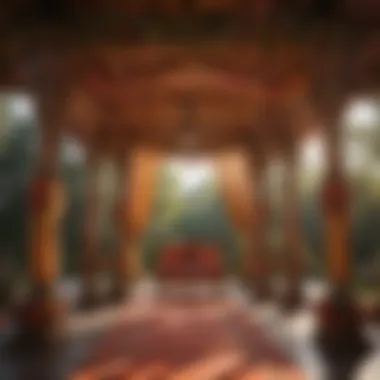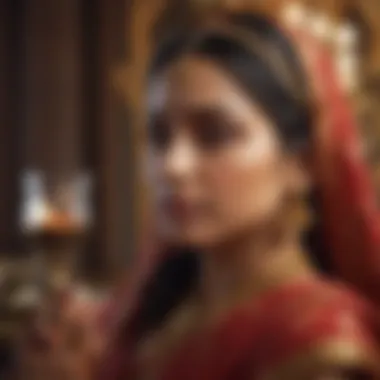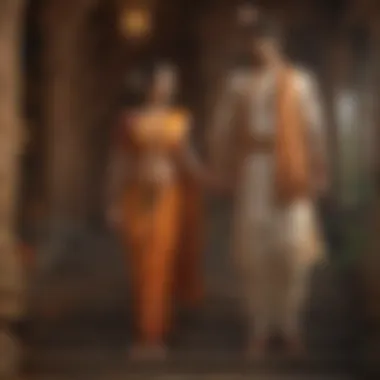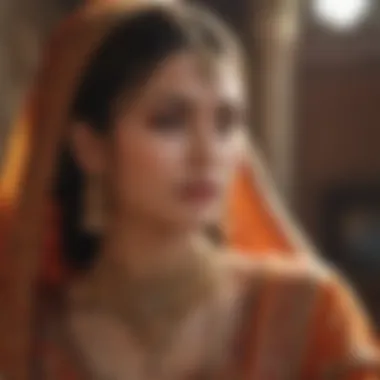Exploring the Rich Traditions of Hindu Wedding Rituals


Intro
A traditional Hindu wedding is a multifaceted affair steeped in rich rituals and profound cultural significance. The ceremonies are not merely performances but rather, they are expressions of deeply held beliefs and value systems. These weddings often encompass a wide array of customs that vary across regions and communities in India. Understanding the intricacies of these traditions can provide meaningful insight into the collective consciousness and societal frameworks within which families operate.
In this article, we delve into the rituals and practices that comprise traditional Hindu marriages, paying special attention to the spiritual beliefs and astrological elements that are pivotal in these unions. From the pre-wedding ceremonies to the main vows exchanged, each step holds profound relevance, connecting individuals not only to each other but also to their heritage and the universe at large.
Intro to Traditional Hindu Weddings
Traditional Hindu weddings are not merely ceremonies, but rather rich tapestries of cultural heritage, emotional connections, and spiritual undertones. They symbolize the sacred union of two individuals, rooted in social customs and ancient practices. Each element of the wedding ritual serves a purpose, reflecting not only personal vows but also societal values and familial bonds. Understanding these nuances enriches our knowledge of Hindu culture and the significance attributed to marital unions throughout history.
Historical Context
The tradition of Hindu weddings dates back thousands of years, intertwining with various historical events and movements. Over time, cultural exchanges and regional influences have shaped these ceremonies, adapting to the evolving social landscape. Manusmriti, a significant ancient text, outlines norms for marriage, illustrating how weddings were an essential part of Hindu society.
Many rituals have their origins in the Vedic period, including the Saptapadi, or the seven steps. These customs reflect the philosophical underpinning of Dharma, Artha, Kama, and Moksha that guide Hindu life. As society progressed, certain rituals evolved or were omitted, achieving a balance between adherence to tradition and modernity.
Significance in Hindu Culture
In Hindu culture, marriage is seen not just as a personal commitment but as a covenant with divine beings. It is believed that the couple's union extends beyond this life into future incarnations. This perception bestows weddings with a spiritual dimension and underscores the importance of compatibility and mutual respect.
The rituals performed during a wedding ceremony convey profound meanings. For example, the Kanyadaan ritual, where the bride is given away by her father, symbolizes the transfer of responsibility and care from family to husband. Here's a closer look at some key aspects of this significance:
- Cultural Heritage: Weddings are steeped in age-old traditions that preserve the customs of the community, passing down values and beliefs through generations.
- Spiritual Connection: Each ritual designed in a wedding reinforces spiritual ideologies, such as the importance of faith and the sacred nature of marriage.
- Social Structuring: The ceremonies often help in social bonding, establishing relationships between families and communities through shared celebrations.
Understanding these dimensions is valuable not only for those participating but also for audiences seeking to appreciate the intricacies of Hindu weddings. Examining these elements reveals the broader cultural narrative that shapes marital practices.
The essence of a traditional Hindu wedding lies in its multifaceted layers of cultural significance, spiritual beliefs, and the social fabric that intricately connect families and communities.
Pre-Wedding Rituals
Pre-wedding rituals are a vital part of traditional Hindu weddings. Each ceremony serves a unique purpose, setting the stage for the main event. These rituals are rich in culture and tradition, embodying the values and beliefs of society. They bring families together and help foster a sense of community. By participating in these rites, families reaffirm their connections, ahead of a significant life event.
Engagement Ceremony
The engagement ceremony marks the official announcement of the wedding. It is a blend of tradition and personal sentiment. During this ceremony, families introduce their children to each other. This event also lays down the groundwork for the wedding arrangements. Typically, the couple exchanges rings, symbolizing their commitment.
The engagement also serves as a platform for both families to express good wishes and blessings. Gifts are often exchanged, reinforcing the bonds between the two sides. This event can be relatively simple but is important as it signifies the start of the wedding journey.
Mehndi Ceremony
The Mehndi ceremony involves the application of intricate henna designs on the bride's hands and feet. This event is vibrant and full of energy. Typically held a day or two before the wedding, it is a joyful gathering of friends and female relatives.
Mehndi is believed to bring good fortune to the bride. As the henna darkens, it symbolizes strong love and affection between the couple. Different patterns hold varied meanings, with some indicating prosperity and happiness. The event is often accompanied by music and dance, creating a festive atmosphere.


Sangeet Night
The Sangeet night is characterized by music and dance performances. This event gathers both families to celebrate. It serves as an opportunity to unite the bride's and groom's families. The performances often showcase traditional songs, lively dances, and sometimes even playful matches between families.
This ceremony enhances relationships and builds a joyful environment. It helps to break the ice between families, fostering connections before the main wedding day. It is not merely entertainment; it reinforces the importance of communal bonds in Hindu weddings.
Importance of Astrological Alignment
Astrology plays a crucial role in Hindu marriages. Before finalizing wedding dates, families seek the guidance of astrologers to ensure compatibility. The position of celestial bodies is believed to impact the relationship's success.
Key considerations include:
- Muhurta: The auspicious timing for the various ceremonies.
- Janam Kundli: The birth charts of the couple to check compatibility.
- Navamsa Chart: Detailed analysis of the couple’s compatibility in various facets of life.
These astrological elements significantly influence wedding preparations. Ensuring favorable alignment is considered essential for a harmonious marital life.
The relevance of these rituals lies not only in tradition but also in their ability to strengthen family bonds, align cosmic energies, and foster joyous connections ahead of a sacred union.
The Wedding Day Rituals
The wedding day is the pinnacle of traditional Hindu wedding ceremonies, where rituals crystallize the union of two individuals. Each ritual holds deep significance and is meticulously planned, reflecting the values and beliefs of Hindu culture. These ceremonies not only bind the couple together but also weave their families into a shared narrative. Understanding the essence and nuances of these rituals offers insight into the collective consciousness surrounding marriage in Hindu society.
The Baraat Ceremony
The Baraat is a colorful procession that heralds the groom's arrival at the wedding venue. It symbolizes not just the groom, but the merging of two families. Friends and family accompany the groom, dancing and celebrating along the way. This exuberance is more than just merriment; it represents the joy and responsibilities of the new life ahead.
Often accompanied by music and traditional attire, the Baraat sets the tone for the impending solemnity of the wedding rites. The bride's family welcomes the groom and his party with warmth, which symbolizes acceptance and approval. The Baraat is a significant opening chapter of the wedding day, embodying the transition from singlehood to marital life.
Kanyadaan: The Giving Away of the Bride
Kanyadaan is an essential ritual wherein the bride's father formally gives his daughter away to the groom. This act carries profound emotional and cultural weight. It symbolizes the father's blessing, encapsulating years of nurturing and love. It marks the transfer of responsibilities and care from the bride's family to the groom, reinforcing familial ties.
“The moment encapsulates both loss and gain, where a daughter’s departure brings a new bond.”
Alongside this, the bride holds her father's hand, indicating the continuity of support even as she embarks on her new journey. It is not merely a transactional aspect of marriage but instead a sacred pledge of trust between families.
The Saptapadi: The Seven Steps
The Saptapadi, or the Seven Steps, is a central tenet of the wedding ceremony, deep-rooted in spiritual significance. The couple takes seven steps together, each representing different aspects of married life.
- Sustenance – Providing for one another.
- Strength – Supporting each other emotionally and physically.
- Prosperity – Aiming for wealth and abundance.
- Family – Nurturing and raising their family.
- Health – Looking after each other’s wellness.
- Harmony – Maintaining a balanced relationship.
- Fidelity – Remaining loyal in the covenant.
These steps solidify the union in the presence of their loved ones, making a vow to uphold values that define their partnership. Each step carries deep astrological implications, as various celestial alignments influence the couple's union, offering a deeper connection to their spiritual journey.
The Role of the Priest


The priest plays an instrumental role in the wedding ceremony, acting as the conduit between the couple and the divine. He recites sacred mantras, guiding the couple through the rituals. The priest's knowledge extends beyond the wedding day; his insights into the couple's horoscopes can also mediate astrological compatibility, enriching the spiritual fabric of their new life together.
His presence reassures the couple, imparting wisdom that resonates throughout their married life. He ensures that the rituals are performed in accordance with tradition, emphasizing the significance of staying aligned with spiritual beliefs. The involvement of a priest signifies respect for ancient customs and underscores the relevance of astrological influences in shaping a successful marriage.
Post-Wedding Ceremonies
Post-wedding ceremonies hold significant importance in traditional Hindu weddings, marking the transition from the wedding event to the couple's new life together. These rituals serve not only to reinforce the bonds formed during the marriage but also to align them with family values and spiritual beliefs. The post-wedding phase often involves ceremonies that integrate both families, emphasizing unity and mutual respect. Here, we focus on two primary ceremonies: Griha Pravesh and the reception.
Griha Pravesh: The Bride's Entrance
Griha Pravesh is a highly meaningful ceremony where the bride officially enters her new home. This ritual signifies her transition from her parental home to her husband’s. It is charged with symbolism and customary practices, emphasizing the bride's new role.
During this ceremony, the bride usually enters with her right foot, which is believed to bring prosperity and good luck to the household. She carries a sacred pot called a Kalash, filled with water and topped with mango leaves and a coconut. This pot signifies abundance and the arrival of auspiciousness in her new home.
In Hindu tradition, the bride may also sprinkle rice at the entrance as a way to welcome positive energy. The priest, or elder family member, often recites specific mantras during this time, invoking blessings for the couple's new journey.
The emotional aspect of Griha Pravesh cannot be understated. The ceremony often evokes a range of feelings for the bride, from nostalgia for her childhood home to excitement for her future. This ceremony sets the tone for her acceptance within her new family and marks a significant cultural shift.
The Griha Pravesh ceremony represents not just physical relocation, but also the spiritual integration of the bride into her husband's family.
Reception and Celebration
The reception is a festive occasion that brings together family and friends to celebrate the union of the couple. This event often includes a grand feast, music, and dance, highlighting the joy of the marriage. The reception varies in scale and style, depending on cultural and regional customs.
During the reception, it is typical for the couple to greet guests and participate in rituals such as exchanging garlands, known as Jaimala. This act symbolizes their acceptance of one another.
Key elements of the reception often include:
- Culinary Offerings: A lavish spread featuring various traditional dishes represents hospitality and the joy of sharing.
- Entertainment: Live music or dance performances enliven the atmosphere, showcasing cultural heritage.
- Gifts: Guests often present the couple with gifts or envelopes containing money as a gesture of goodwill.
- Speeches: Family members and friends might share anecdotes and well-wishes, adding a heartfelt touch to the proceedings.
The reception serves as a bridge that reinforces social connections, allowing families to unite through celebration. It is a reflection of communal joy and offers a glimpse into the couple's support network.
In summary, post-wedding ceremonies are not merely procedural; they are rich in significance and serve to anchor the newlyweds in their cultural context. The Griha Pravesh and reception embody the core values of family, unity, and tradition, making them essential components of the traditional Hindu wedding experience.
Cultural Variations in Hindu Weddings
Cultural variations in Hindu weddings are not merely optional embellishments; they reflect the diverse tapestry of traditions that exist within the Hindu community worldwide. Each variation is a unique expression of cultural identity, beliefs, and regional practices. Understanding these variations enriches our insight into Hindu weddings and illustrates how local customs intermingle with ancient traditions.
Regional differences play a crucial role in forming the distinct characteristics of wedding ceremonies. For instance, a Punjabi wedding often showcases vibrant colors, loud celebrations, and energetic dances, while a South Indian wedding may emphasize simplicity, traditional attire, and elaborate rituals. Each region's climate, agricultural practices, and social structures have shaped its wedding customs, proving that the setting directly impacts the celebratory practices.
Regional Differences
In the vast landscape of India, regional variations flourish. Each state has its own customs, dress codes, and rituals. In Maharashtra, for example, couples often wear a nauvari saree and dhoti, whereas in Gujarat, one might see the bride adorned in a colorful chaniyo choli ensemble. These unique attires serve as a visual representation of the rich history and regional diversity.


Ceremonies also vary significantly. In Bengali weddings, the bride is often carried in a 'palki,' signifying her transition into motherhood. In Tamil Nadu, parents perform a ceremony called 'Kashi Yatra' where the groom pretends to leave for Kashi, an important pilgrimage. These rites, while different in execution, share the core purpose of marking the unity of two souls.
Different Customs Across Communities
Different communities within Hinduism bring their own set of rituals to the wedding table. The Marathas might prioritize a ritual known as 'Sankalpa,' where prayers align the couple's horoscopes. Conversely, the Rajputs have elaborate traditions around 'Gori Poojan,' a ceremony that venerates the goddess of fertility.
These customs not only define the wedding experience but also symbolize the values each community upholds. Rituals can signify familial hierarchy, showcasing how the blending of cultures brings diverse values and perspectives into the public domain.
Astrological Factors in Hindu Marriages
Astrology holds a significant position in Hindu matrimonial practices. For many, the alignment of celestial bodies at the time of a person’s birth can dictate personal characteristics and life events. By understanding astrological factors, families often look to facilitate harmonious unions and mitigate potential issues.
The Role of Horoscopes
Horoscopes are pivotal in Hindu marriages. They provide insights derived from the position of planets and stars. When two individuals consider marriage, their horoscopes are compared during a ceremony known as Kundali matching. This process assesses compatibility, evaluating multiple factors.
Some of the major elements taken into account include:
- Guna Milan: A point system based on the birth star and moon signs, which evaluates emotional and intellectual compatibility.
- Dosha: Specific afflictions that can influence marital harmony. These can include Mangal Dosha or Kaal Sarp Dosha, which need careful consideration.
- Strength of Navamsa: This governs the husband-wife relationship, guiding future prospects and challenges.
Families place great importance on this analysis to ensure their children marry into a well-matched partnership. The hope is that favorable planetary positions will bring prosperity and well-being to the couple.
Mangal Dosha and Its Impact
Mangal Dosha, often referred to as “Kuja Dosha,” occurs when Mars is positioned unfavorably in the horoscope. Its implications can be significant. The presence of Mangal Dosha might become a deciding factor in arranged marriages, often raising concerns about compatibility and future marital happiness.
Some implications of Mangal Dosha include:
- Strained Relationships: Believed to cause discord in marriage.
- Health Concerns: Possible impact on the well-being of the partners.
- Wealth Issues: Mangal Dosha can also affect the financial stability of the family.
These perceptions can lead families to consider remedies if Mangal Dosha is present. Common solutions include theme rituals, gem therapy, or marrying a person of specific astrological alignments, such as marrying after a certain age or marrying a tree or symbol before the actual marriage.
Astrological factors in marriages are not merely superstitions; they reflect deep-seated cultural beliefs and practices that shape individual lives and community relationships.
The End
Reflecting on the Importance of Tradition
Tradition serves as the backbone of any culture, and in the context of a traditional Hindu wedding, it carries a multi-faceted significance. First, these rituals often encompass values that have been handed down through generations. Each ceremony, from the engagement to the final rites, reflects not merely the union of two individuals but also their families and communities. Thus, the emphasis on tradition contributes to a collective identity. This identity is reinforced by rituals that promote social cohesion and define moral values.
Further, traditional elements provide a sense of continuity in a rapidly changing world. While modern influences are increasingly apparent, many families choose to honor their heritage through these time-honored customs. This balance between maintaining tradition and adapting to contemporary influences is an ongoing negotiation that showcases the dynamic nature of culture. As such, traditional Hindu weddings become a site where personal and communal identities intersect, thereby offering a rich tapestry of cultural significance.
The Future of Hindu Weddings
As society evolves, so too do the customs surrounding Hindu weddings. The integration of modern values and social views is changing how these ceremonies are perceived and executed. Increasingly, couples are opting for more personalized ceremonies that reflect their unique backgrounds, beliefs, and preferences. Technology also plays a role; the incorporation of online platforms for planning and even streaming events reaches audiences beyond geographic boundaries.
Another emerging aspect is the more prominent discussions surrounding gender roles within weddings. Many couples are negotiating traditions to ensure a more equitable partnership. The introduction of joint rituals or mutual participation underscores a shift in societal norms. This adaptability speaks to a larger trend of redefining relationships within the framework of marriage.
In summary, while the essence of traditional Hindu weddings lies in their rich tapestry of rituals and symbolism, the future promises to blend these age-old practices with contemporary values. Maintaining this balance offers insight into the broader cultural shifts and evolving societal norms. The marriages of tomorrow will likely reflect an enriched dialogue between tradition and modernity, contributing to the continuing evolution of Hindu wedding practices.



